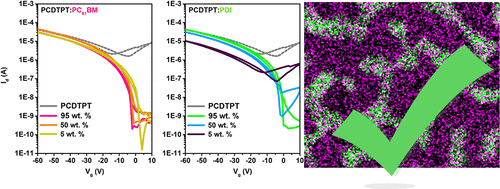Our official English website, www.x-mol.net, welcomes your
feedback! (Note: you will need to create a separate account there.)
Acceptor Percolation Determines How Electron-Accepting Additives Modify Transport of Ambipolar Polymer Organic Field-Effect Transistors
ACS Nano ( IF 15.8 ) Pub Date : 2018-05-31 00:00:00 , DOI: 10.1021/acsnano.8b03006 Michael J. Ford , Ming Wang , Karen C. Bustillo 1 , Jianyu Yuan 2 , Thuc-Quyen Nguyen , Guillermo C. Bazan
ACS Nano ( IF 15.8 ) Pub Date : 2018-05-31 00:00:00 , DOI: 10.1021/acsnano.8b03006 Michael J. Ford , Ming Wang , Karen C. Bustillo 1 , Jianyu Yuan 2 , Thuc-Quyen Nguyen , Guillermo C. Bazan
Affiliation

|
Organic field-effect transistors (OFETs) that utilize ambipolar polymer semiconductors can benefit from the ability of both electron and hole conduction, which is necessary for complementary circuits. However, simultaneous hole and electron transport in organic field-effect transistors result in poor ON/OFF ratios, limiting potential applications. Solution processing methods have been developed to control charge transport properties and transform ambipolar conduction to hole-only conduction. The electron-acceptor phenyl-C61-butyric acid methyl ester (PC61BM), when mixed in solution with an ambipolar semiconducting polymer, can reduce electron conduction. Unipolar p-type OFETs with high, well-defined ON/OFF ratios and without detrimental effects on hole conduction are achieved for a wide range of blend compositions, from 95:5 to 5:95 wt % semiconductor polymer:PC61BM. When introducing the alternative acceptor N,N′-bis(1-ethylpropyl)-3,4:9,10-perylenediimide (PDI), high ON/OFF ratios are achieved for 95:5 wt % semiconductor polymer:PDI; however, electron conduction increases for 50:50 and 5:95 wt % semiconductor polymer:PDI. As described within, we show that electron conduction is practically eliminated when additive domains do not percolate across the OFET channel, that is, electrons are “morphologically trapped”. Morphologies were characterized by optical, electron, and atomic force microscopy as well as X-ray scattering techniques. PC61BM was substituted with an endohedral Lu3N fullerene, which enhanced contrast in electron microscopy and allowed for more detailed insight into the blend morphologies. Blends with alternative, nonfullerene acceptors further emphasize the importance of morphology and acceptor percolation, providing insights for such blends that control ambipolar transport and ON/OFF ratios.
中文翻译:

受体渗滤确定电子接受添加剂如何改变双极性聚合物有机场效应晶体管的传输
利用双极性聚合物半导体的有机场效应晶体管(OFET)可以受益于电子和空穴传导的能力,这是互补电路所必需的。然而,有机场效应晶体管中同时的空穴和电子传输导致差的开/关比,限制了潜在的应用。已经开发出溶液处理方法来控制电荷传输性质并将双极性传导转换为仅空穴传导。电子受体苯基-C61-丁酸甲酯(PC 61BM)与双极性半导体聚合物在溶液中混合时,会降低电子传导。对于从95:5到5:95 wt%的半导体聚合物:PC 61 BM的各种共混组合物,可以实现具有高的,明确定义的ON / OFF比且对空穴传导没有有害影响的单极p型OFET 。当引入替代受体N时,N'-双(1-乙基丙基)-3,4:9,10-per二酰亚胺(PDI),对于95:5 wt%的半导体聚合物:PDI实现了高开/关比; 然而,对于50:50和5:95 wt%的半导体聚合物:PDI,电子传导增加。如其中所述,我们表明,当附加域不渗透到整个OFET通道时,即,电子被“形态上捕获”时,实际上消除了电子传导。形貌通过光学,电子和原子力显微镜以及X射线散射技术进行表征。PC 61 BM被内膜Lu 3取代N富勒烯,可增强电子显微镜的对比度,并允许更详细地了解共混物的形态。与替代性非富勒烯受体的共混物进一步强调了形态学和受体渗滤的重要性,从而为控制双极性传输和开/关比的此类共混物提供了见识。
更新日期:2018-05-31
中文翻译:

受体渗滤确定电子接受添加剂如何改变双极性聚合物有机场效应晶体管的传输
利用双极性聚合物半导体的有机场效应晶体管(OFET)可以受益于电子和空穴传导的能力,这是互补电路所必需的。然而,有机场效应晶体管中同时的空穴和电子传输导致差的开/关比,限制了潜在的应用。已经开发出溶液处理方法来控制电荷传输性质并将双极性传导转换为仅空穴传导。电子受体苯基-C61-丁酸甲酯(PC 61BM)与双极性半导体聚合物在溶液中混合时,会降低电子传导。对于从95:5到5:95 wt%的半导体聚合物:PC 61 BM的各种共混组合物,可以实现具有高的,明确定义的ON / OFF比且对空穴传导没有有害影响的单极p型OFET 。当引入替代受体N时,N'-双(1-乙基丙基)-3,4:9,10-per二酰亚胺(PDI),对于95:5 wt%的半导体聚合物:PDI实现了高开/关比; 然而,对于50:50和5:95 wt%的半导体聚合物:PDI,电子传导增加。如其中所述,我们表明,当附加域不渗透到整个OFET通道时,即,电子被“形态上捕获”时,实际上消除了电子传导。形貌通过光学,电子和原子力显微镜以及X射线散射技术进行表征。PC 61 BM被内膜Lu 3取代N富勒烯,可增强电子显微镜的对比度,并允许更详细地了解共混物的形态。与替代性非富勒烯受体的共混物进一步强调了形态学和受体渗滤的重要性,从而为控制双极性传输和开/关比的此类共混物提供了见识。










































 京公网安备 11010802027423号
京公网安备 11010802027423号